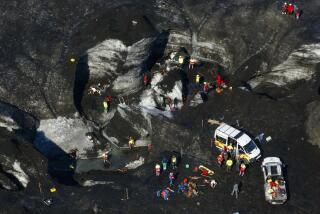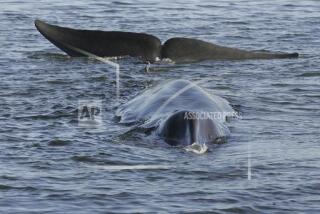Iceland volcano calming down
- Share via
The volcanic eruption that has been disrupting air travel across Northern Europe appears to be subsiding, and volcanologists said Tuesday that they were hopeful that the worst of it may be past.
The volcano beneath the Eyjafjallajokull glacier in Iceland is still emitting ash, but less of it and less explosively, scientists reported. That means the ash is not being ejected as high into the atmosphere — only about half as high as Monday — and thus is falling to the ground much closer to the volcano, presenting less of a threat to the major air lanes over Europe.
Volcanologists attributed the change to two main factors. The first is a reduced flow of magma into the volcano chamber; the second is that most of the glacier in the immediate vicinity of the volcano has already melted, so there is now little water pouring into the crater.
“Before, lava was melting its way through the ice, and the inclusion of water in the [eruption] process makes it more explosive,” said volcanologist Simon Carn of Michigan Technological University. “Most of the ice now seems to have melted away, and the lava can release its gas without creating ash. That seems to be what is going on now.”
The volcano also seems to be deflating, “and that is a fairly good sign, for the next few days at least,” said volcanologist Olivier Bachmann of the University of Washington. In the weeks and months leading up to the eruptions — first of magma from a fissure on the side of the volcano and then of ash from the crater itself — the infusion of magma into the volcanic chamber caused the volcano and all the land around it to swell up, lifting it a few inches above normal level.
Now satellite sensors and GPS units on and around the slopes of the volcano show that the land is slowly sinking back, indicating the pressure that caused the eruption is subsiding.
“It looks like we might be heading toward a quieter time, but that can change very rapidly,” Bachmann said.
Volcanologist Chris Waythomas of the U.S. Geological Survey cautioned that the situation could change at any time. “Eruptions wax and wane, and sustained ash emissions don’t go on indefinitely,” he said. A similar situation occurs with volcanoes in Alaska, he said. “You get explosive activity, it quiets down for a week or so, then it re-erupts again.”
If the Eyjafjallajokull volcano begins to swell again, that would be a sign that it may be preparing for another eruption. Icelandic volcanologists are monitoring the surface level very carefully for signs of such a change.
“The instruments can give a warning that something is going to happen, but not how big it will be” or what type of eruption will occur, Waythomas said.
So far, the eruption does not seem to be affecting the nearby Katla volcano, which is about 10 times as large. The last three times that Eyjafjallajokull erupted, Katla did as well. Seismologists have not observed any premonitory seismic activity around Katla.
“It doesn’t seem to be waking up at this point,” Bachmann said.
More to Read
Sign up for Essential California
The most important California stories and recommendations in your inbox every morning.
You may occasionally receive promotional content from the Los Angeles Times.










